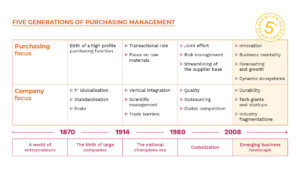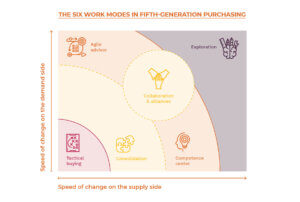For a long time, in order to stay competitive, companies have asked procurement professionals to recommend strategies for economies of scale and cost reduction through the standardization of products and services. And let’s face it, these strategies have generated significant benefits!
While still relevant today, these approaches are no longer sufficient to maintain a high level of competitiveness or to meet the ever-increasing client demands.
Purchasing : an evolving and competitive sector
Buying isn’t a new phenomenon! The organization of purchasing activities in businesses started at the beginning of industrialization 150 years ago. At that time, emphasis was placed on tactical activities (ordering, tracking deliveries, receiving and paying invoices), but the reality of business has since evolved considerably.
Businesses seek to differentiate themselves in their market by taking actions focused on the customization of their products at competitive prices and on social and environmental responsibility, among other factors. The ecosystem in which a business operates is increasingly complex and geographically expansive.
The approach and management of supplier-partners is a key factor in the success of any organization. This type of management is not random—it requires special skills and aptitudes.
Today, the purchasing function is still responsible for reducing costs. But it must also support the company in its search for innovation and in its goal to focus on its core business functions. This is achieved by helping the company outsource other activities through an ecosystem consisting of suppliers who have developed niches of particular expertise.
The 5th generation buyer
These new requirements and skills have led the EIPM (European Institute of Purchasing Management) to define 5th generation buyers and confirm them in a much more strategic role so that they generate all the value expected by their leaders. The evolution of the purchasing function in organizations has been rightly defined by Hervé Legenvre and Bernard Gracia of the EIPM in their book Fifth-Generation Purchasing – When pace meets power 1.
According to the authors, the Purchasing function is in its “5th generation,” having already crossed through four generations in the last 150 years.
Within this framework, purchasing operates according to two dimensions: 1) the speed of the change in demand, and 2) the speed of the change in supply. If the speed of change is low on both sides, focus will be placed on sourcing commodities or standardized solutions. If the speed of change is high on both sides, then we will adopt a model focused on the innovation of the supplier market for the company. At the centre, we favour a way of working based on the search for personalized solutions. These modes are not static—you can switch from one mode to another depending on the situation.
Focus on skills development
Skills development is therefore critical—even strategic—for companies, particularly in terms of the purchasing function.
Corporate objectives are ambitious (profitability, customer satisfaction, etc.), and the supplier market is becoming more complex. You must be able to offer your teams the means and tools to help achieve these goals.
In order to properly target the areas of development, however, it is essential to identify the skills already acquired and those that must be developed. In turn, these skills should align with good procurement practices.
We note that this upstream analysis of purchasing skills is an approach too often neglected by organizations.
Companies quickly target training that is too general, poorly adapted to their needs, and which, as a result, prevents their teams from achieving internal objectives or managing the realities of external ecosystems.
Continuous improvement is vital for the competitiveness of a business. Our experts understand that training must be targeted, based on concrete learning and transferable on a daily basis. They also know the importance of rendering it profitable.
Stay tuned, as we’ll cover the basics of the 5th generation buyer in our upcoming blog posts and explain in more detail the new skills that define them—and why.
1 Hervé Legenvre et Bernard Gracia, Fifth-Generation Purchasing – When pace meets power, European Institute of Purchasing Management (février 2020), 231 p.





